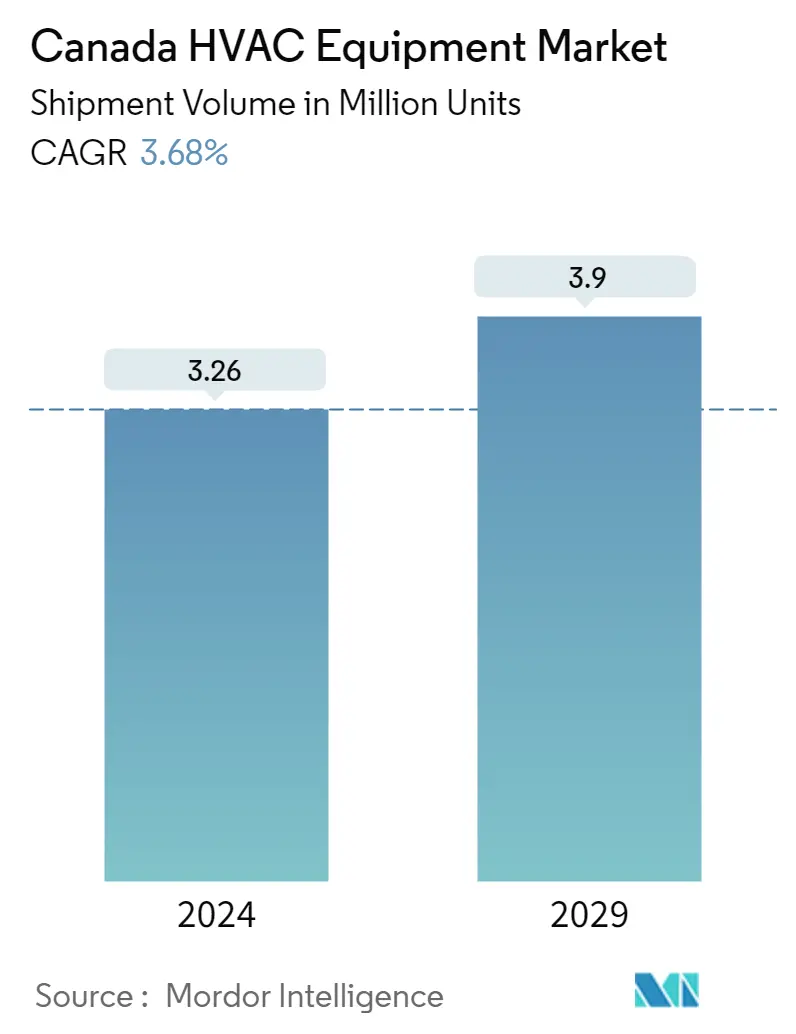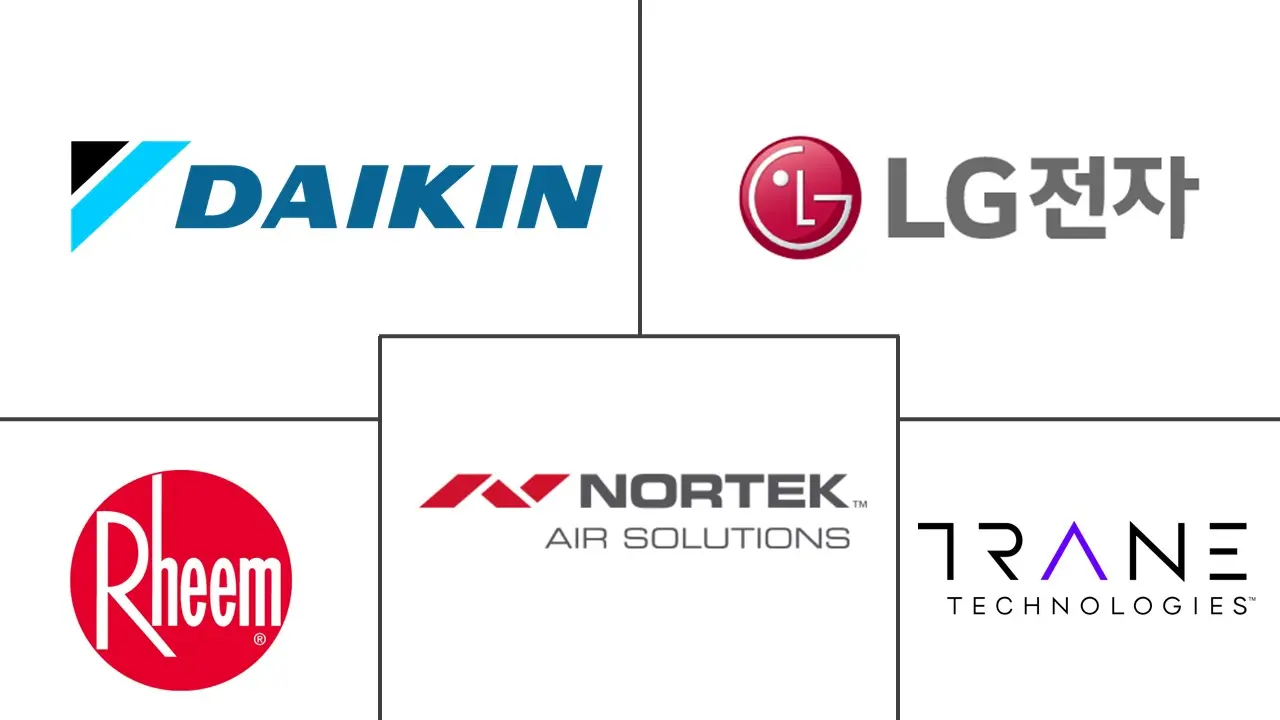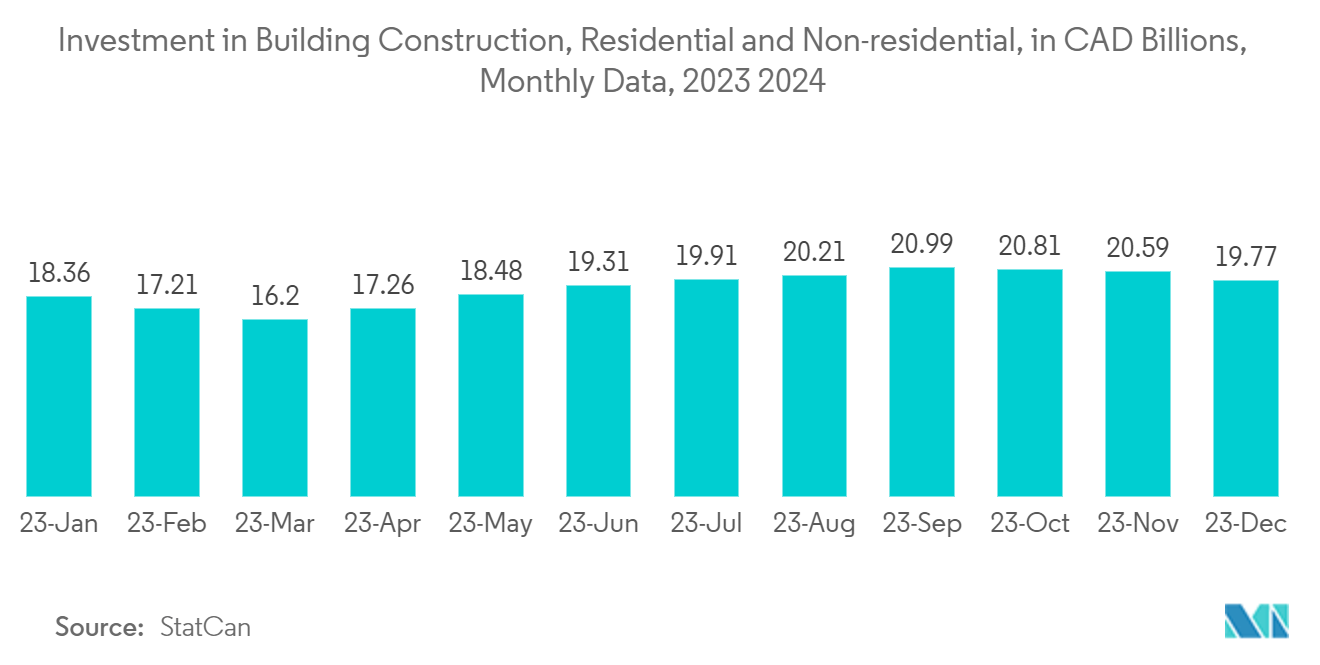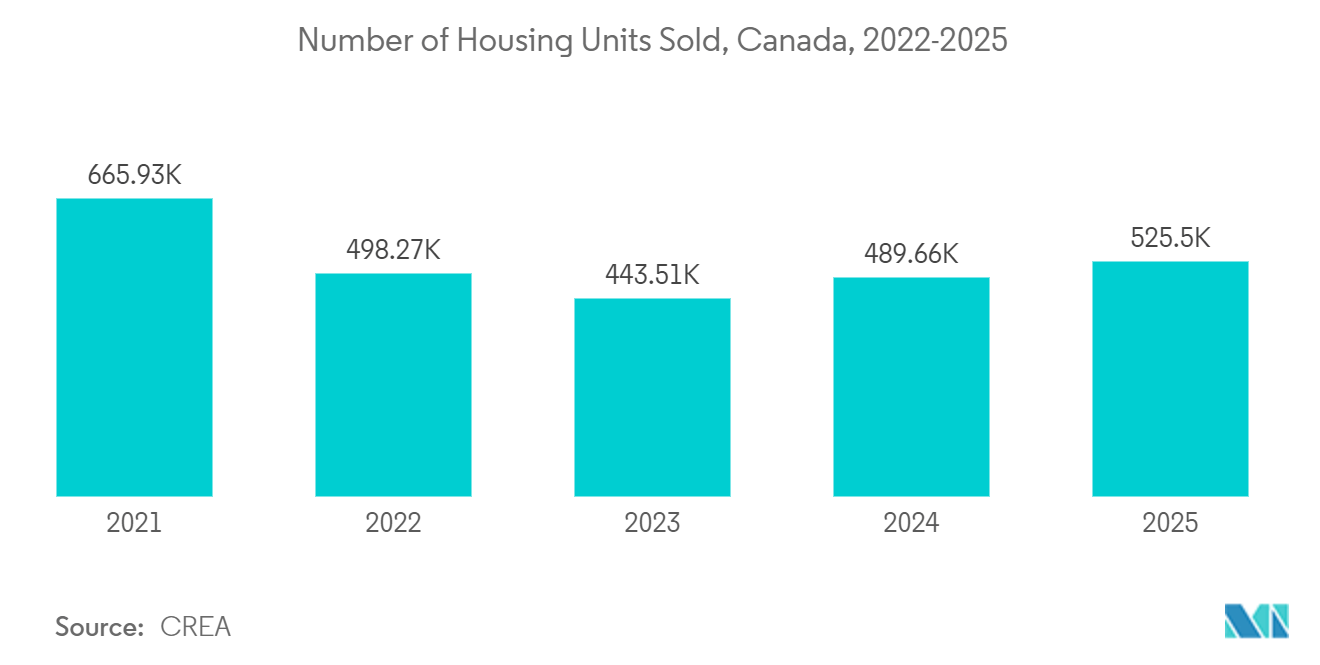Canada HVAC Equipment Market Size

| Study Period | 2019 - 2029 |
| Base Year For Estimation | 2023 |
| Market Volume (2024) | 3.26 Million units |
| Market Volume (2029) | 3.9 Million units |
| CAGR (2024 - 2029) | 3.68 % |
| Market Concentration | Low |
Major Players
*Disclaimer: Major Players sorted in no particular order |
Need a report that reflects how COVID-19 has impacted this market and its growth?
Canada HVAC Equipment Market Analysis
The Canada HVAC Equipment Market size in terms of shipment volume is expected to grow from 3.26 Million units in 2024 to 3.9 Million units by 2029, at a CAGR of 3.68% during the forecast period (2024-2029).
Heating, ventilation, and air conditioning (HVAC) equipment are systems for circulating air between indoor and outdoor areas and heating and cooling in residential and commercial buildings. These techniques also filter and clean indoor air and maintain humidity at optimal levels. Government initiatives, such as rebates and tax incentives for energy-efficient HVAC installations, encourage consumers and businesses to invest in newer, more efficient systems. Also, increasing awareness of the importance of indoor air quality and its impact on health is driving the demand for HVAC systems with advanced filtration and ventilation capabilities across the country.
- There are initiatives in Canada offering rebates for installing energy-efficient equipment such as heating systems and heat pumps. Islanders can access both the Government of Canada's Greener Homes Grant and efficiency PEI rebates. Citizens who fall below the income level of CAD 35,000 are eligible for larger rebates. In May 2023, the Canadian government and the province of Manitoba joined forces to provide millions to upgrade ventilation, heating, and cooling equipment (HVAC) in Manitoban schools and healthcare facilities. These initiatives are likely to boost the growth of HVAC systems.
- With the country aiming for net-zero emissions by 2050, the Canadian government is encouraging the adoption of energy-efficient HVAC devices, such as heat pumps, air conditioners, and others, which is another primary market growth driver. As a result, large HVAC vendors are active in the region, and their numerous investments in new product launches are assisting the government in meeting its objectives.
- Further, in terms of heating equipment, though most Canadian households use forced-air heating systems to warm their homes, the demand for heat pumps, which are more energy-efficient than air furnaces, is expected to rise significantly in the coming years. This is driven by favorable government initiatives promoting heat pump adoption. Additionally, ventilation equipment, such as air handling units, is becoming popular as air pollution levels grow and people become more conscious of maintaining a healthy and safe atmosphere.
- The need to upgrade existing buildings with more efficient HVAC systems to reduce energy consumption and operational costs contributes to market growth. For instance, in November 2023, a joint investment of more than USD 384,000 was made to support retrofits to the Carnegie Building in Saint John. Announced by MP Wayne Long and Mayor Donna Reardon, this project will significantly help to reduce the facility's carbon footprint. The investment will help improve the heating, ventilation, and air conditioning (HVAC) system throughout Carnegie Building, creating significant energy savings for a cultural landmark of the city.
- Canada is also witnessing significant vendor activities in terms of air source heat pump technology. For instance, in December 2023, Terravis Energy, a subsidiary of Worksport Ltd, a Canadian technology company, unveiled a prototype of a residential air source heat pump designed for heating and cooling purposes. The heat pump boasts a coefficient of performance (COP) of approximately 1.8 and a seasonal coefficient of performance (SCOP) of around 3.0. Currently, the prototype utilizes R32 refrigerant, which has a global warming potential (GWP) of 675. Worksport Ltd mentioned that it aligned with the new 2024 mandate in Canada, which requires refrigerants to have a GWP of 750 or lower. These significant advancements will be crucial in determining the region's future availability of heat pump technology.
- According to the International Energy Agency (IEA), Canada is considering requiring energy performance better than a factor of 1 (corresponding to an equipment efficiency of 100%) for all heating systems by 2030, thereby banning all conventional coal-oil and gas-fired boilers. Such activities are anticipated to stimulate the demand for Heat pumps in the Canadian market.
- According to a research article from the Journal of Exposure Science and Environmental Epidemiology published in 2023, out of 4,500 respondents in Canada, 90% had mechanical ventilation devices over the cooktop (66% of which were vented to the outside), and 30% reported regularly using their device. Amidst increasing wildfires and rising toxic pollution levels during such disasters, there is an increasing need for exhaust and air filtration systems.
- Manufacturers are facing many efficiency requirements and changes to refrigerants that are primarily driven by the US Department of Energy (DOE), which has a significant impact on the market in Canada. New DOE energy efficiency standards for 2023 were expected to significantly impact all rooftop units sold in Canada. Moreover, the filters, coils, and fins, among others, of an HVAC system, such as an air conditioner, require regular maintenance for the equipment to work efficiently and effectively throughout its operating life. Neglecting necessary maintenance will reduce air conditioning performance and significantly increase energy consumption.
- The conflict between Russia and Ukraine is expected to impact the electronics industry significantly. The conflict might cause extra disruptions and affect the supply chains of semiconductors, leading to further increases in the prices of electronics. Overall, the impact of the conflict on the electronics industry is expected to be significant. This would hamper the production of the country's HVAC equipment.
Canada HVAC Equipment Market Trends
Surge in Construction Activities is Driving the Market
- The construction sector in Canada plays a significant role in propelling the demand for HVAC (Heating, Ventilation, and Air Conditioning) equipment. As the construction sector experiences growth with new residential, commercial, and industrial projects, there is a simultaneous demand for HVAC systems to provide heating, cooling, and ventilation for these buildings. HVAC equipment is essential for ensuring occupant comfort and maintaining indoor air quality in newly constructed spaces. According to FMI Corporation, construction spending for all construction projects in Canada amounted to approximately USD 360.33 billion in 2023. By 2027, it is expected to cross USD 401 billion.
- In 2024, the Canadian Prime Minister announced a package of USD 600 million for new construction technology. This includes research and development of new ideas such as prefabricated housing factories, mass timber production, 3D printing, etc. The country supports new construction tech to make it easier to build cost-effective homes faster. Such initiatives are expected to bolster the construction sector, eventually increasing the demand for HVAC equipment.
- With the rise in climate change awareness, builders and regulators alike in the region are seeking to decrease the carbon footprint of commercial and industrial construction. Construction guidelines such as Net Zero have established a standard for sustainable building practices. Heavy government subsidies also make it more affordable to meet the higher upfront costs sometimes associated with green construction.
- With the expansion of commercial sectors, including office buildings and retail spaces, there is a growing demand for HVAC equipment to provide climate control and ventilation in these facilities. As businesses expand or relocate, they often invest in new HVAC systems tailored to their needs. According to CBRE Group, Canada's new office space supply reached 6.73 million square feet in 2023.
- Building renovation projects by the government to make them more energy-efficient is significantly rising in the Canadian market. This is because energy-efficient buildings can help reduce greenhouse gas emissions, lower energy bills for homeowners and businesses, and improve indoor air quality, thus making them suitable for public health. Therefore, with the growing construction and retrofit activities, there will be a significant rise in the demand for energy-efficient HVAC equipment for maintaining comfortable indoor temperatures and good air quality in buildings, owing to support climate changes, abiding by energy regulations, technology automation, and building automation.

The Residential Segment Holds a Significant Market Share
- HVAC demand is increasing in the nation owing to an increase in the number of luxury residential infrastructure projects. Over the forecast period, additional factors, including increased urbanization and rising per capita income of consumers in emerging nations, are anticipated to generate several opportunities for market players. Total residential and nonresidential investments in January 2024 amounted to CAD 18.4 billion. In October, November, and December of 2023, investments stood at around CAD 20.8 billion, 20.59 billion, and 19.76 billion, respectively. Around 66% of the investment in January 2024 was dedicated to residential construction.
- According to CREA, the number of home sales in 2023 was recorded at 443,511, and it is expected to reach almost 525,500 by 2025. In May 2023, Lennox collaborated with its network of residential dealers to honor deserving community heroes in Canada by providing free heating or cooling equipment and installation.
- Due to tighter government controls on energy emissions from residential buildings worldwide, HVAC systems are becoming more prevalent in the residential sector. To comply with the emission laws, several market vendors continually invest in new product introductions and residential HVAC subscription programs. The Canadian government encourages consumers to buy air conditioners with Energy Star as an Energy Star-certified central air conditioner uses 8% less energy on average than a standard model. Due to such regulations, HVAC vendors offer equipment according to government standards. Due to the RTUs rule, more vendors are concentrating on commercial buildings and sustainable skyscrapers.
- Given the variable climate and harsh winters, HVAC systems have become necessary in most Canadian homes. Many places in Canada face extreme heat events or heat waves involving high temperatures and high humidity. As per the preliminary figures released by the BC Coroners Service, 619 people died from severe heat in British Columbia during the most extended summer heat wave.
- Canada is increasingly facing a housing crisis with uncertainty over unaffordable real estate prices and rents. The government is bolstering its initiatives to meet the increasing demand for real estate. As inflationary pressure subsides, the segment is expected to resume its upward trajectory. This will, in turn, increase the demand for HVAC equipment.
- In recent years, as per a survey conducted by Statistics Canada, sales of electrical, plumbing, heating, and air-conditioning equipment and supplies to wholesalers amounted to approximately CAD 38.86 billion (USD 29.12 billion) recently, and it stated that around three in five Canadian households own an air conditioner. Among them, 42% reported having a central air conditioner, 17% a stand-alone, and 3% another type of air conditioner. Also, according to A-Plus Air, around 65% of Canadian homes are warmed by forced-air furnaces, most of which are powered by natural gas, and others use propane or oil. Furnace-based heating systems are popular because they can heat a room quickly. With some modifications, a forced-air furnace can even be roped into function as an air filter, fresh-air ventilator, or humidifier. Another benefit is that the same duct systems can be deployed for air-conditioning during warmer summer months.
- In February 2023, it was announced that Wolseley Canada and GE Appliances, a Haier subsidiary, Air & Water Solutions, will collaborate to provide the Canadian market with a full line of high-end heating, ventilation, and air conditioning equipment. Furnaces, air conditioners, air handlers, heat pumps, evaporator coils, and package units are among the new residential ducted HVAC line-ups from GE Appliances Air & Water Solutions that provide the utmost in-home comfort. The latest products are expected to be offered at Wolseley Canada stores across Canada.

Canada HVAC Equipment Industry Overview
The Canadian heating, ventilation, and air conditioning equipment market is highly fragmented. Key players include Daikin Industries Ltd, LG Electronics Inc., Nortek Air Solutions LLC, Rheem Manufacturing Company Inc., and Trane Technologies PLC. Players in the market are adopting techniques such as collaborations and acquisitions to improve their product offerings and gain sustainable competitive advantage.
- December 2023: Daikin launched new expansion valve kits and a control box to easily connect Daikin DX (Direct Expansion) outdoor units with Air Handling Units. Operating with refrigerant R-32 and R410a, these kits offer an energy-efficient and low-carbon solution for heating, cooling, and fresh air control to ensure optimal comfort in any commercial space.
- July 2023: Greenheck introduced XG-TH-500 series air terminal units. Greenheck’s XG-TH-500 Series Air Terminal Units (ATU) are zone-level air distribution devices that regulate airflow for maximum occupant comfort in variable or constant volume applications. The single-duct XG-TH-500 features a Greenheck - XG-TH-500 Series galvanized steel casing mechanically sealed for low leakage construction, a round inlet damper, an inlet flow sensor, and a rectangular outlet.
Canada HVAC Equipment Market Leaders
Daikin Industries Ltd
LG Electronics
Noertek
Rheem Manufacturing
Trane Technologies PLC
*Disclaimer: Major Players sorted in no particular order
_Equipment_Market.webp)
Canada HVAC Equipment Market News
- February 2024: Rheem, a company that produces water heating and HVACR products, introduced its latest heat pump called the Endeavor Line Classic Plus Series Universal Heat Pump RD17AZ. The Rheem RD17AZ, which is Energy Star certified, was recognized as the most efficient unit for the year 2024, even in cold weather conditions. This heat pump is compatible with almost any HVAC system or can be used as a Universal Replacement with minimal modifications needed.
- January 2024: Carrier Corporation partnered with Montana Technologies to bring to market a cooling technology that reduces carbon emissions for HVAC systems. Carrier also agreed to provide USD 10 million in growth equity to help support the commercialization of Air Joule's dehumidification and cooling technology in Montana.
- September 2023: BrainBox AI and Trane Technologies collaborated to develop automated HVAC decarbonization controls. The primary goal of the collaboration is to enhance existing HVAC systems in multiple retail locations throughout North America. This collaboration came after BrainBox AI's purchase of ABB's energy management system for multi-site retailers in May.
Canada HVAC Equipment Market Report - Table of Contents
1. INTRODUCTION
1.1 Study Assumptions and Market Definitions
1.2 Scope of the Study
2. RESEARCH METHODOLOGY
3. EXECUTIVE SUMMARY
4. MARKET INSIGHTS
4.1 Market Overview
4.2 Industry Attractiveness - Porter's Five Forces Analysis
4.2.1 Threat of New Entrants
4.2.2 Bargaining Power of Buyers
4.2.3 Bargaining Power of Suppliers
4.2.4 Threat of Substitute Products
4.2.5 Intensity of Competitive Rivalry
4.3 Industry Value Chain Analysis
4.4 Impact of Macroeconomic Trends on the Market
5. MARKET DYNAMICS
5.1 Market Drivers
5.1.1 Surge in Construction Activity
5.2 Market Challenges
5.2.1 High Maintenance and Repair Costs
6. TECHNOLOGICAL SNAPSHOT
7. MARKET SEGMENTATION
7.1 By Type of Equipment
7.1.1 Air Conditioning
7.1.1.1 Ducted Split Systems
7.1.1.2 Ductless Split Systems
7.1.1.3 Packaged Units and Rooftops
7.1.1.4 Chillers
7.1.1.5 Unit Heaters
7.1.2 Heating
7.1.2.1 Warm Air Furnaces (Gas, Electric, Oil, and Combination)
7.1.2.2 Heat Pumps
7.1.3 Ventilation
7.1.3.1 Air Handling Units
7.2 By End-user Industry
7.2.1 Residential
7.2.2 Commercial
8. COMPETITIVE LANDSCAPE
8.1 Company Profiles
8.1.1 Daikin Industries Ltd
8.1.2 LG Electronics Inc.
8.1.3 Nortek Air Solutions LLC
8.1.4 Rheem Manufacturing Company Inc.
8.1.5 Trane Technologies PLC
8.1.6 Johnson controls International PLC
8.1.7 Carrier Corporation
8.1.8 Engineered Air
8.1.9 Gree Canada
8.1.10 Mitsubishi Electric Corporation
- *List Not Exhaustive
9. INVESTMENT ANALYSIS
10. FUTURE OF THE MARKET
Canada HVAC Equipment Industry Segmentation
HVAC equipment is a comfort technology for indoor and vehicle environments that provides thermal comfort and acceptable indoor air quality. This applies to residential buildings such as apartments, single-family homes, hotels, and elderly communities, as well as medium- and large-scale industrial buildings such as clinics, where safe and healthy building conditions are controlled in terms of temperature and humidity. It is also essential for office buildings as it adjusts humidity using fresh air from outside.
The Canada HVAC equipment market is segmented by type of equipment (air conditioning {ducted split systems, ductless split systems, packaged units and rooftops, chillers, and unit heaters}, heating {warm air furnaces [gas, electric, oil, and combination], and heat pumps}, ventilation {air handling units}), and end-user industry (residential and commercial). The report offers market forecasts and sizes in terms of volume (shipment in units) for all the above segments.
| By Type of Equipment | |||||||
| |||||||
| |||||||
|
| By End-user Industry | |
| Residential | |
| Commercial |
Canada HVAC Equipment Market Research FAQs
How big is the Canada HVAC Equipment Market?
The Canada HVAC Equipment Market size is expected to reach 3.26 million units in 2024 and grow at a CAGR of 3.68% to reach 3.9 million units by 2029.
What is the current Canada HVAC Equipment Market size?
In 2024, the Canada HVAC Equipment Market size is expected to reach 3.26 million units.
Who are the key players in Canada HVAC Equipment Market?
Daikin Industries Ltd, LG Electronics, Noertek, Rheem Manufacturing and Trane Technologies PLC are the major companies operating in the Canada HVAC Equipment Market.
What years does this Canada HVAC Equipment Market cover, and what was the market size in 2023?
In 2023, the Canada HVAC Equipment Market size was estimated at 3.14 million units. The report covers the Canada HVAC Equipment Market historical market size for years: 2019, 2020, 2021, 2022 and 2023. The report also forecasts the Canada HVAC Equipment Market size for years: 2024, 2025, 2026, 2027, 2028 and 2029.
Canada HVAC Equipment Industry Report
Statistics for the 2024 Canada HVAC Equipment market share, size and revenue growth rate, created by Mordor Intelligence™ Industry Reports. Canada HVAC Equipment analysis includes a market forecast outlook 2029 and historical overview. Get a sample of this industry analysis as a free report PDF download.
